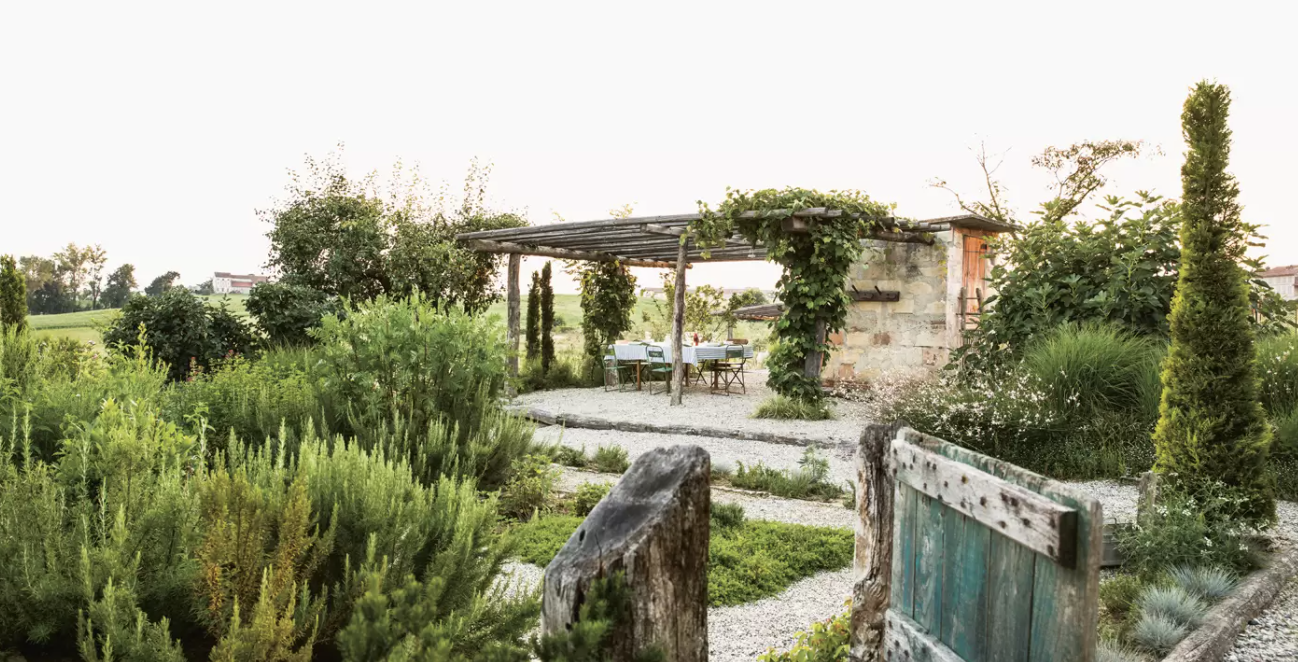With a vegetable patch for the home chef and playful pathways for the kids, copious flowers for the aesthete and comfy perches where all can relax, you can have a garden that checks all the boxes. Functional gardens are the way of the future. Read more, ‘Key Outdoor Trends To Make The Most Out Of Your Garden.’
Here’s how to pull it all together, (inhospitable slopes, included).
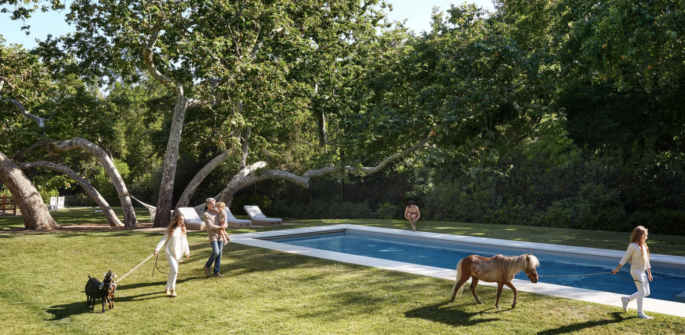
An inviting oasis in which all ages can wander, gather, and play where the lawn is brought right up to the pool coping, for a more contemporary approach.. Image via Archdigest.com
Even if you have nothing you could call a yard – where your main entrance opens onto a barren hillside that is extremely steep, do not be deterred.
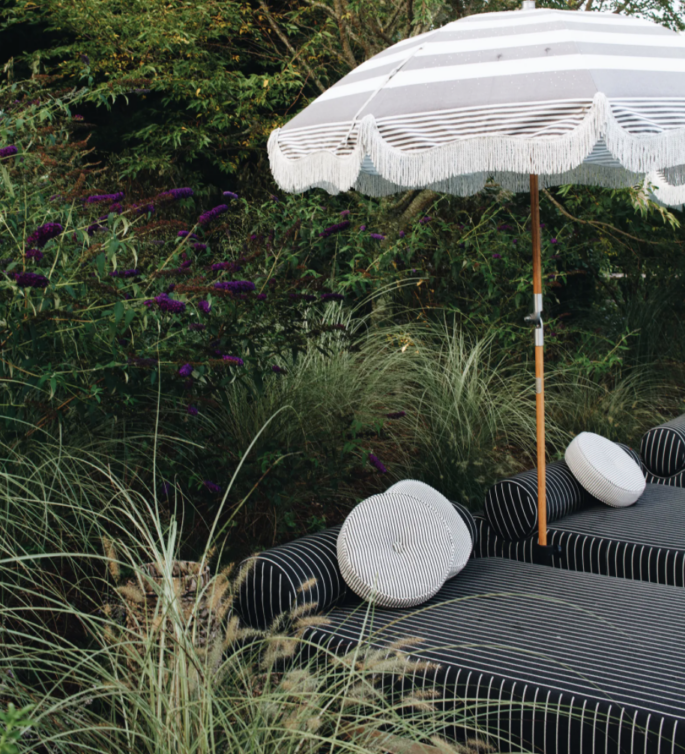
Jeremiah Brent uses the landscape around the home—to create a deck surrounded by lots of ferns, rock ledges, and evergreen tree. Photo: Courtesy of Jeremiah Brent
A layered garden might be the solution where the family cook can work on their vegetables, school-age kids can explore, and entertainers can have a spot to lounge.
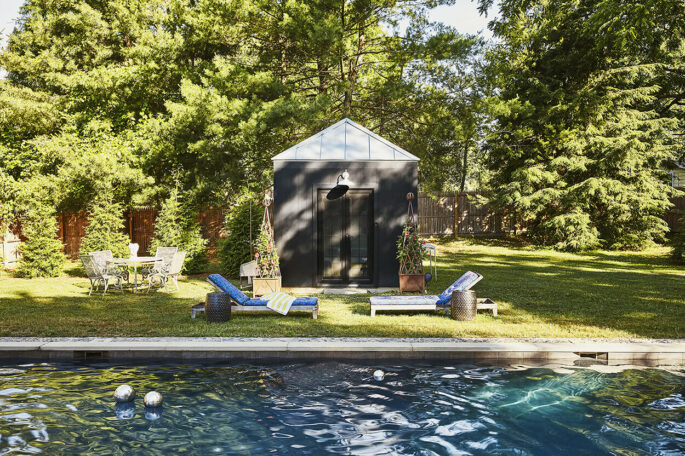
Bring your lawn right up to the pool coping to creates a resort-like beauty. Chaises and chairs can sit on minimal landscaping. Image via frankfrances.com
You might be able to introduce a mix of classical French design features—a parterre potager, espaliered fruit trees, and geometric boxwood hedges—yielding a romantic landscape that’s cultivated and dynamic. Here, are five strategies to help homeowners recast a less-than-ideal plot into a welcoming haven.
Inviting oases in which all ages can wander, gather, and play prove that a “family-friendly” garden doesn’t need to be all lawn.
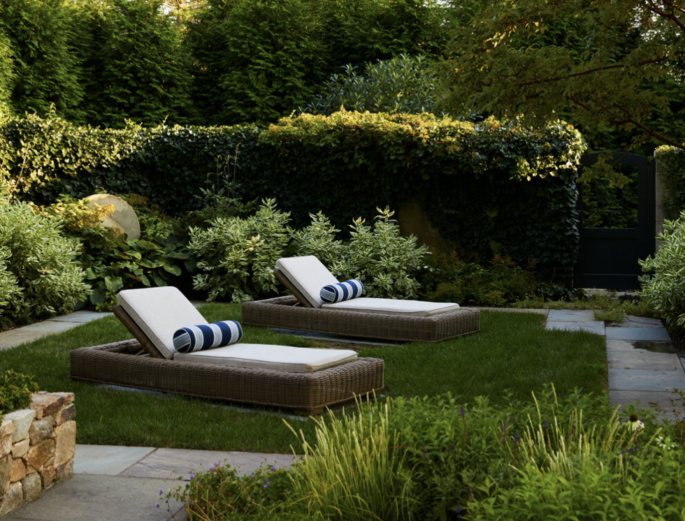
Tim Lentz, timlenzphoto.com
Open Invitation
Thanks to the quirks of the terrain, one of your yard’s primary outdoor seating areas—a grouping of chairs and table might nestle against a wall covered in creeping fig and set among whimsical boxwood topiaries—positioned in an unconventional location: directly across from the home’s front door. Potted evergreens, pruned into geometric sculptures, and a potted orange tree underplanted with greenery can embrace the seating area to make it even more inviting. Read more, ‘How To Create An Outdoor Room.’
People might think: “Can I really entertain here?’’ But why not? It’s very welcoming and the perfect gathering place before setting off further to explore.

From the checkered tiles to the painted ceiling, there are so many aesthetic considerations to make an outdoor space an extension of your interior home and invite the outside in. Photo: Courtesy of Jeremiah Brent
Simplifying the garden
If your garden used to be on five levels try combining them, to create a patio area with a big dining terrace and built-in seating for 12. Read more, ‘Making a Modern Garden.’
A pergola means you are always sitting under a canopy of roses or jasmine in summer.
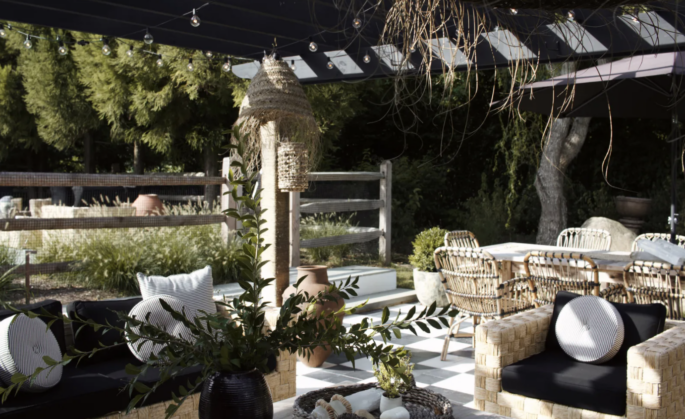
A superb example of an outdoor entertaining setting. Photo: Courtesy of Jeremiah Brent
Found Fruit
Punctuate your view, and create little moments of magic that really transport you to Europe and another time. Added trees might bring drama and texture that attract wildlife. You could also introduce dwarf olive bushes, “brioche”-style boxwoods, and sprays of hardy carpet roses that give way to a meandering hedge of lemon trees. Read more, ‘Your First Garden: How to Start A Garden For Practically Nothing.’
Try weaving fruit and vegetables into the landscape by lining the front of your cutting bed with a border of strawberries, or plant blueberries with roses.
To walk along a path and be able to pluck a bite and pop it into your mouth is a happy experience. Small gardens had a dwarf fruit tree or three. In addition to the fruit, a lovely side benefit of fruit trees is that they blossom in spring and gnarled tree trunks and branches take on a dramatically sculptural look when covered in snow. Read more, ‘Your Guide To The Ultimate Garden Transformation.’
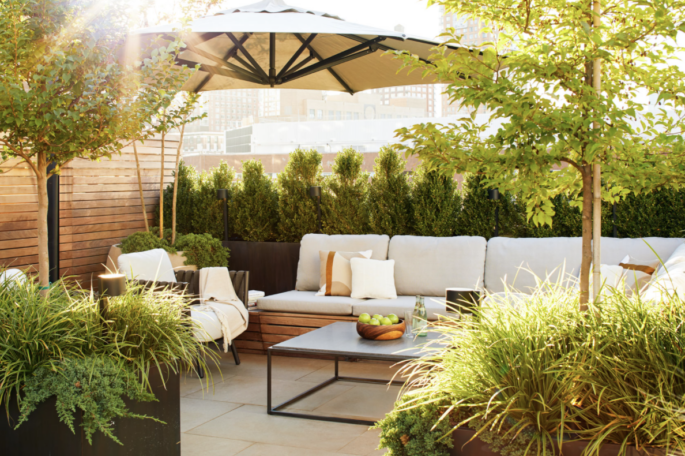
Ty Cole, tycole.com
Arty Vegetables
Decide on a good spot where you will can plant your vegetables or walk by them often. Start by thinking about visibility and sun. This way you can notice when plants need harvesting or tending to. Also, the spot needs to receive at least 6 hours of sun a day, unless you live in a super hot climate, then you might be able to get away with a little less. Raised beds are better. They are more moisture-rich and usually better draining than open ground.
Even a simple retaining wall built at a depth of about 15 centimetres is a smart option. Also, by raising or containing areas, you can be sure the soil you plant in (and the food you harvest and eat) is pesticide- and chemical-free.By clustering plants together, you can better trap moisture and allow taller plants to provide shade to smaller plants. Read more, ‘Key Outdoor Trends To Make The Most of Your Garden All Year.’
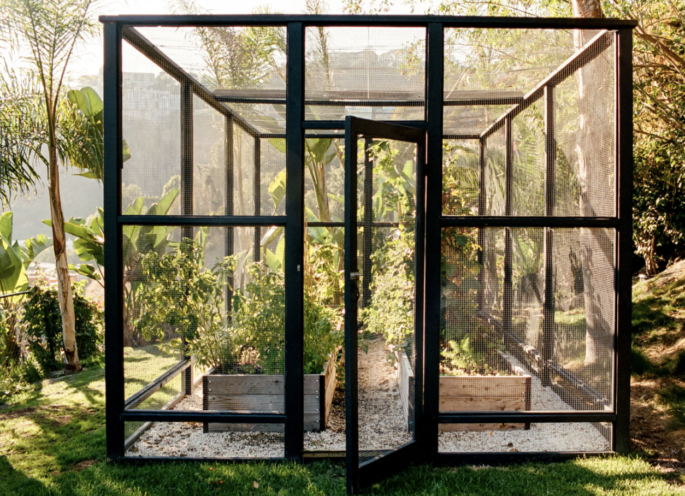
For a tiered look, plant crops that stay close to the ground toward the front and taller ones at the back. Image via Architectural Digest. Photo: Brian W. Ferry
Plan before you plant
Where you scatter seeds or plant seedlings will determine the overall look of the garden in the weeks or months to come, so think carefully about the layout of your crops—even sketch it out—before you plant. In formal gardens, plant in more traditional rows. Read more, ‘Want A Gorgeous Garden Fast? Here’s What To Plant.’
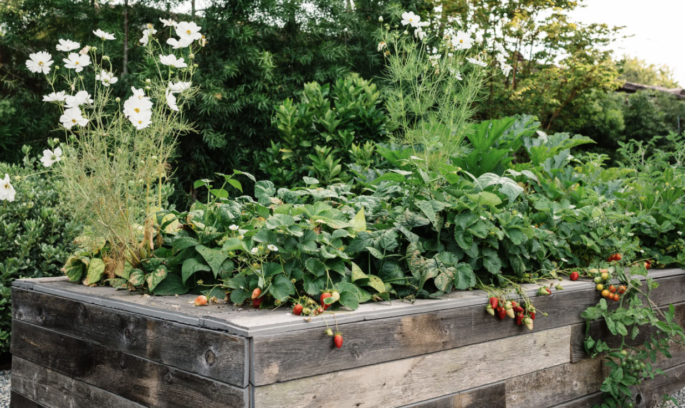
Plants can look just as good as they taste. Image via Architectural Digest. Photo: Brian W. Ferry
In a more free-flowing space, interplant different vegetables, thinking about texture, colour, and form. Five favourites for a fail-safe starter vegetable garden are radishes, parsley, kale, arugula and radicchio.
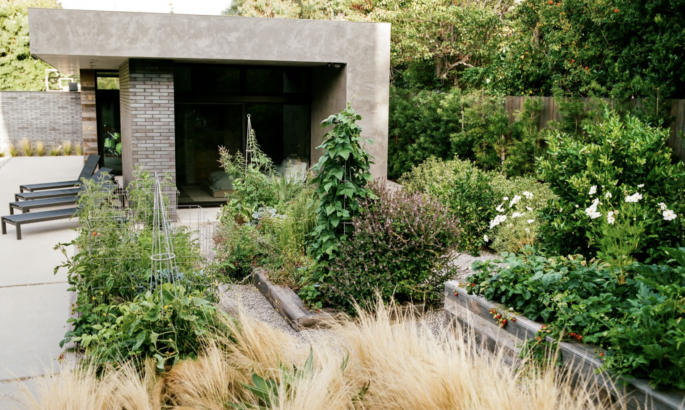
Planting flowers in an edible garden isn’t just pretty, it’s practical. Image via Architectural Digest. Photo: Brian W. Ferry
Reflect The Sky In Your Garden
Add a fountain, pool, pond, birdbath or simple bowl of water. In the right light, the surface of the water will connect the sky to the landscape and create a sense of limitless space. Read more, ‘Key Outdoor Trends To Make The Most of Your Garden All Year.’
For pure pleasure, a fountain is a celebration.
Thousands of years ago, the landscape feature was proof of a successful water delivery system. In gardens these days a fountain often is considered a “decorative” feature, partly because it brings so much pleasure to a landscape. It sounds lovely, that burble. A jet of water is hypnotic to watch as it catches the sunlight and throws a fine, bright mist into the air.

In gardens these days a fountain often is considered a “decorative” feature, partly because it brings so much pleasure to a landscape. It sounds lovely, that burble. Image via Architectural Digest. Photo: William Waldron
Impose Control Over Nature
An unorthodox topography or steep embankment might free you to be a little less formal in your design. Different garden levels, with mature trees and shrubs, and some box hedging. In gardens that are not very big, because of the way they’re terraced you can grow plants up the walls and we have lots of plants in pots. Chose species that attract bees. An ever-changing assortment of colourful container blooms, potted orange trees and lush terraced beds need to be grounded. Think of a patio and walkway of rusticated stone or brickwork below. Read more, ‘How To Improve Your Outdoor Space.’
The best approach is always to try and find some sort of structure in the chaos.
Add a tailored element to an otherwise shaggy outdoor space. A tightly clipped ball of boxwood, say, or a path that turns at a right angle will convey the deliberateness of your intentions even if you let a few plants go shaggy. Similarly, a staid linear wall of creeping European fig contrasts with the tidal wave of distinctive, feathery cobweb bush that crests dramatically and spills over it. It’s fine if you want to plant eight different perennials in one small area, but everything can’t be wild and crazy.
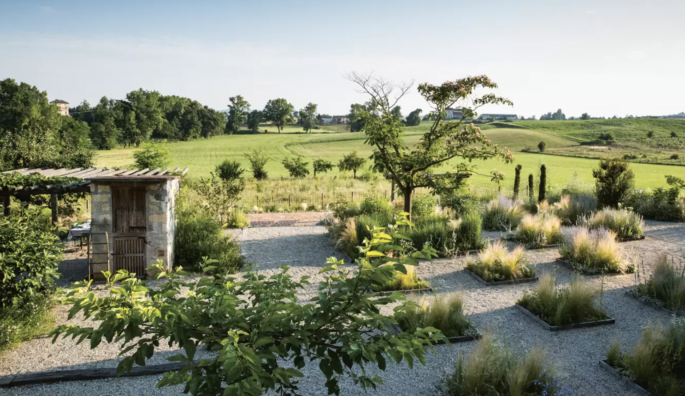
Garden designer Cristina Mazzucchelli has created a bucolic resort landscape that is both ethereal and self-sustaining. Here- a chessboard of square flower beds overflows with soft grasses and herbaceous plants blooming in pink, blue, and white. Photo: House & Garen UK.

